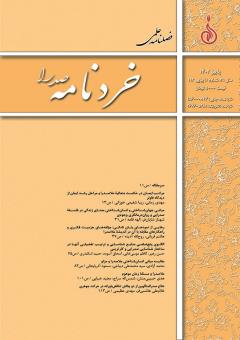مراتب ایمان در حکمت متعالیۀ ملاصدرا و مراحل رشد ایمان از دیدگاه فاولر
محورهای موضوعی : Studies on Mulla Sadra and the Transcendent Philosophyمهدی زمانی 1 , زیبا شفیعی خوزانی 2
1 - دانشیار گروه الهیات، دانشگاه پیام نور، تهران، ایران
2 - استادیار گروه الهیات، دانشگاه پیام نور، تهران، ایران
کلید واژه: ایمان, مراتب ایمان, رشد ایمان, حکمت متعالیه, ملاصدرا, فاولر,
چکیده مقاله :
ملاصدرا بر اساس مبانی حکمت متعالیه، بویژه حرکت جوهری، تشکیک در مراتب وجود، انسان و شناخت، به بیان مراتب ایمان پرداخته است. او گاه ایمان را به تقلیدی، برهانی و عیانی و گاهی به ظاهری و حقیقی و همچنین به لفظی، معنایی، حقیقی (برهانی یا کشفی) و استغراق در نور احدیت تقسیم کرده است. از نظر او، اوج ایمان از آنِ کاملان در عقل نظری و عملی است که اندک افرادی از آنان به خلافت الهی و انسان کامل میرسند. جیمز فاولر، الهیدان و روانشناس معاصر، با تأثیرپذیری از برخی الهیـدانـان جـدید مسیحـی ماننـد تیلیـخ و روانشناسانی مانند پیاژه، کولبرگ و اریکسون، رشد ایمان را در شش مرحله تبیین کرده اسـت: 1) شهـودیـتصویری، 2) اسطورهیـیـواقعی، 3) تـرکیبـیـعـرفـی، 4) انـفـرادیـانتقـادی، 5) پیونددهنده، 6) دین جهانی. وسعت نظر شناختی و اخلاقی خویش، نمونهیی از مرحلۀ ششم ایمان هستند. در این نوشتار ابتدا با روش توصیفیـتحلیلی به تبیین دیدگاه ملاصدرا درباب مراتب ایمان و دیدگاه فاولر دربارۀ مراحل رشد ایمان پرداخته و سپس به مقایسۀ نقاط اشتراک و تفاوت و ارزیابی ایندو دیدگاه پرداخته شده است.
Mullā Ṣadrā has discussed the levels of faith based on the principles of the Transcendent Philosophy, particularly the trans-substantial motion and gradation of the levels of existence, Man, and knowledge. He divides faith sometimes into imitative, demonstrative, and obvious types and sometimes into external and true, verbal, semantic, real (demonstrative or unveiled) and drowning into the light of oneness types. In his view, the highest level of faith belongs to masters of theoretical and practical intellect, only a few of whom reach the level of divine vicegerency and the perfect Man. James Fowler, the contemporary theologist and psychologist, explains the growth of faith at six stages: 1) intuitive projective faith, 2) mythic-literal faith, 3) synthetic-conventional, 4) individuative reflective faith, 5) conjunctive faith, and global faith. He does so under the influence of certain modern Christian theologians, such as Tillich, and psychologists, such as Piaget, Kohlberg, and Erikson. Fowler believes that figures like Mahatma Gandhi and Mother Teresa exemplify the sixth level of faith in the light of their cognitive and moral breadth of insight. Here, following a descriptive analytic method, the authors initially explain Mullā Ṣadrā’s view regarding the levels of faith and Fowler’s view of the stages of the growth of faith and then compare, contrast, and evaluate the two views.
